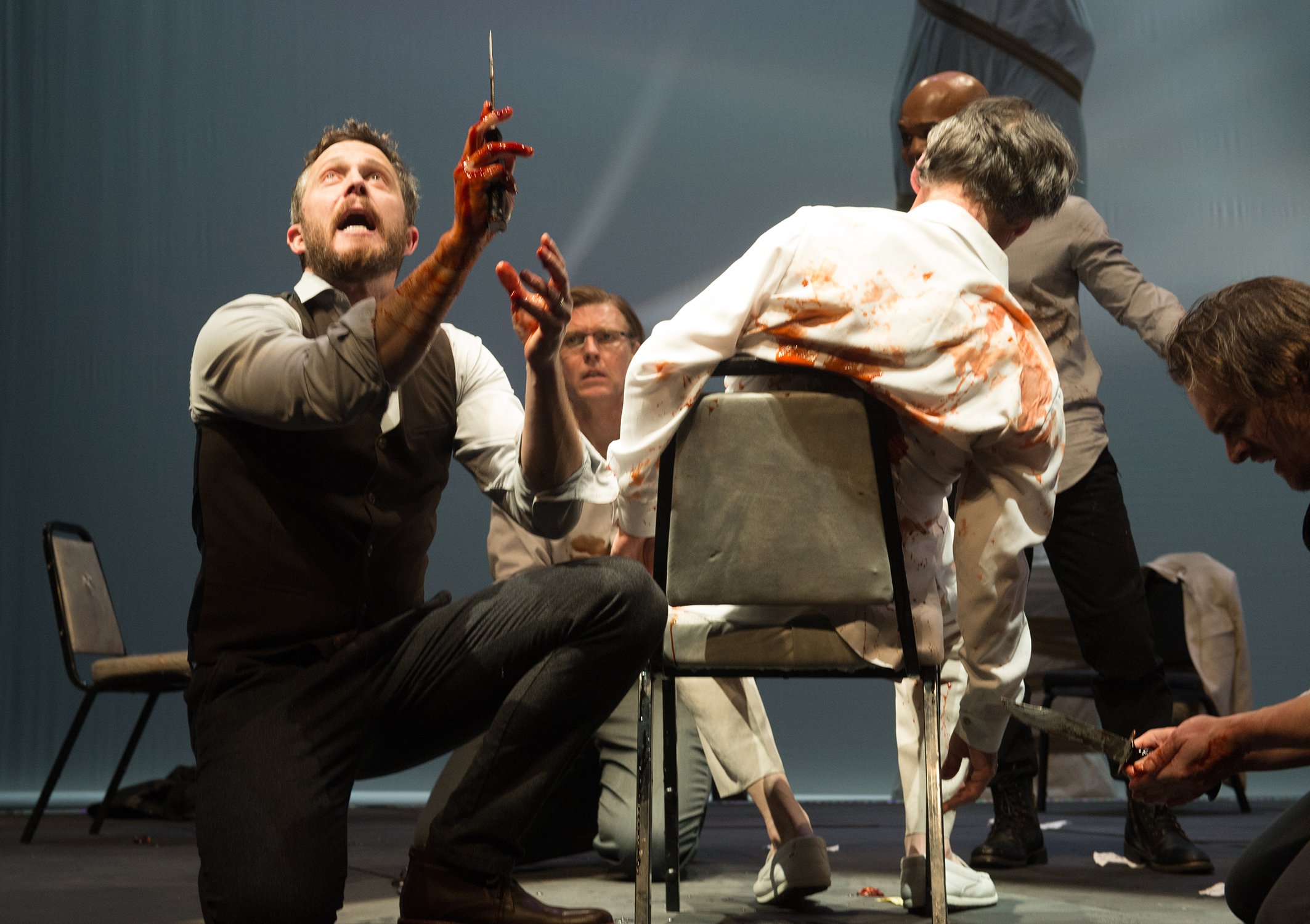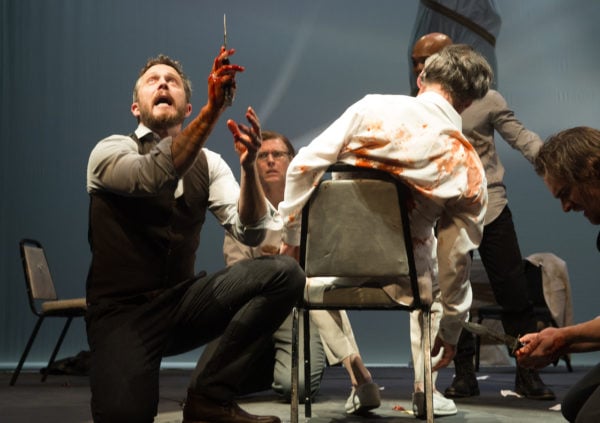
The Oregon Shakespeare Festival (OSF) offers a selection of Shakespearean works as part of its 2017 season, including “Henry IV, Part 1,” “Henry IV, Part 2,” “The Merry Wives of Windsor” and “Julius Caesar” — the first two histories, the third a comedy and the fourth a tragedy. “Henry IV, Part 1” was produced on an arena stage — indicating more intimate audience seating encircling the entire theater — while “Julius Caesar” was presented on a traditional proscenium stage, with the stage on one side and raked seating curved around the other side.
“Henry IV, Part 1” follows the playboy Hal, heir to the throne and future Henry V, who revels in wine, women and song with his friends, most notably his portly pal Falstaff. In the meantime, his father — Henry IV — is busy suppressing rebel uprisings and pacifying the disgruntled Percy family, who feels unvalued after helping him ascend to the throne. One of Shakespeare’s most famous histories, “Henry IV” molds a mostly historically accurate account of the proceedings, albeit with a bit of character conflation to tone down the already complex character-family dynamics and kinship.
The Oregon Shakespeare Festival production, directed by Lileana Blain-Cruz, provides a modern take on the classic tale. Prince Hal (Daniel José Molina) is instead a rowdy modern-day playboy, whose behavior and mannerisms are not unlike that of Jean-Ralphio Saperstein from “Parks and Recreation.” He parties at strip clubs with Falstaff (G. Valmont Thomas) and his friends — lights flashing, music blaring and digital airhorns pounding the audiences back into their seats as Hal chugs alcohol and jumps into an inflatable pool filled with foam falling from the ceiling. His youthful obnoxiousness is almost endearing — a welcome contrast from his uptight father Henry IV (Jeffrey King), who is easily angered and on edge about betrayal and the oncoming inevitable war. The vengeful Harry Percy (Alejandra Escalante), now gender-bent into a headstrong woman and army general, shares only a tender moment with her wife before having to sweep off to war. The female Percy was my favorite shakeup of them all, as this change was able to portray a gender dynamic often unseen in Shakespearean works. The archetypal male figure with the soft, mild-mannered wife is also turned on its head when Percy’s wife (Nemuna Ceesay), in a bout of perceived playfulness, pulls Percy’s dagger from its sheath and demands more than a moment together. Percy, on the hand, is able to be both loving wife and battle-hardened soldier fighting for who she loves and what she believes in. The Shakespearean male soldier is typically expected to be a fighter, driven by ambition or vengeance, so this juxtaposition in turn permits Percy to become an incredibly multifaceted character, allowing her to take on both the traditional male and female Shakespearean personas — both a fighter and a lover.
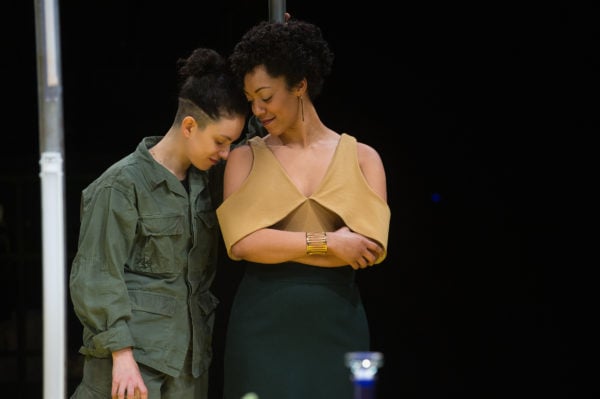
In addition, the contemporary manifestation of Hal creates an even more intriguing three-dimensional look at the young prince as he constantly mocks the foolish Falstaff with full awareness of his future role as king, but still uncaring of the world’s perception of his behavior. Few wealthy, young present-day heirs of companies or countries may have the foresight to recognize their own condition and understand that they will eventually have to snap out of it in order to become leaders of their respective dominions. This, in fact, may make Hal the most powerful, most ingenious character of them all — he knows his power but chooses not use it, instead befriending obsequious lowlifes and subverting expectations at the last moment in a complete metamorphosis to become the prince that the kingdom needs.
His stark transformation, however, is what truly highlights Molina’s skill. In a matter of moments, Molina’s Hal turns from shrieking young buffoon — still in his ripped, paint-covered jeans, high-tops and blazer-covered shirt — into a solemn figure filled with calm rage, ready to rise against Percy. Hal’s confrontation with his father, along with his change of garb into black army raid gear and eventual single combat killing of Percy, completes Hal’s journey for this play — although to be continued in “Henry IV, Part 2.” Nevertheless, this transformation transfixed me. Hal was truly right — being a playboy-turned-hardened-soldier is definitely much more impressive of a change than obedient-prince-turned-slightly-more-obedient-heir.
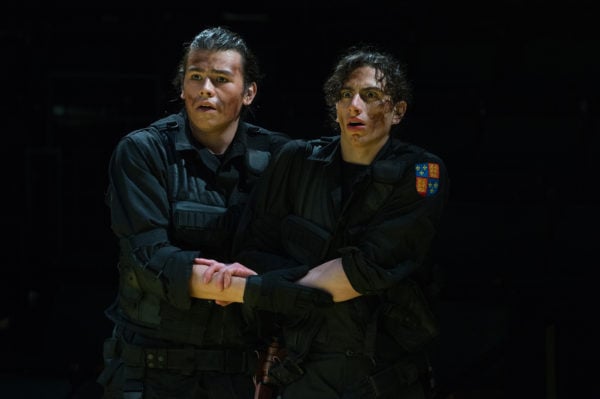
The final segment of the play — mostly held in the dark, only with the beams from soldiers’ flashlights and minimal stage lighting to illuminate the space — becomes a tension-filled scene of war-stricken panic, whose visuals and audio cues of violent gunshots are reminiscent of thriller war films such as “Zero Dark Thirty.” This brings about a fantastically strong conclusion to the play, finishing up the modern-day parallels that mirrors imagery of military missions against contemporary international rebel groups. Whether this is a commentary or simply a clever reflection of what we see in media today remains unclear to me, but it is without a doubt an unforgettable interpretation.
“Julius Caesar,” on the other hand, tackles a different beast. Classically defined as a tragedy — although with historical roots — the play is one of Shakespeare’s most widely recognized, with its distinguishing feature being that the protagonist is a tragic hero. Like “Henry IV,” its titular character is not its main — “Caesar” instead follows Brutus (Danforth Comins), whose hamartia (or fatal flaw) is being too trusting. Brutus is convinced by the senator Cassius (Rodney Gardiner) to join a conspiracy to kill the possibly power-hungry Caesar (Armando Durán) and must follow through the civil war that follows, with his fatal flaw eventually serving as his downfall.
Directed by Shana Cooper, this production almost felt dystopian in nature — from the cracking, crumbling sheets of white wall that sliced the stage in pieces to the divide between the well-dressed senators and the gray masks as well as the very stereotypically “primitive” and “tribal” screeches and outfits of the commoners. Both the set design by Sibyl Wickersheimer and costume design by Raquel Barreto contributed to the strong feeling of divisiveness between the powerful, persuasive senators and the Roman followers, the latter whose masks and similar clothing depicting anonymity and a form of group consciousness. This beautifully-illustrated contrast helps to draw a line between the patricians and the plebeians, reflecting an always-divided upper class and easily swayed working class.
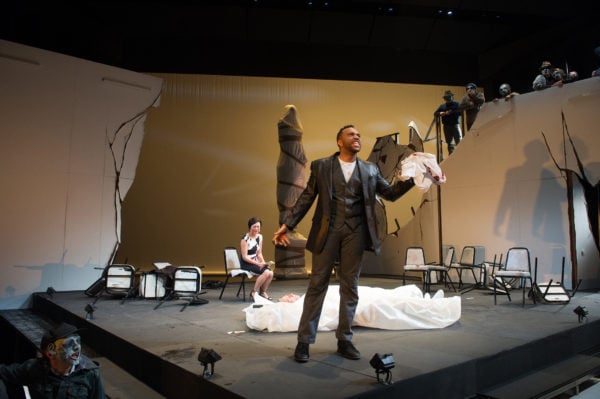
The play became increasingly more symbolic as it went on, beginning with the violent, bloody murder of Caesar and other very bold visual and audio elements. The more representational nature of the production fueled a broader interpretation of the text as a reflection of today’s society while still catering to a traditional Shakespearean lens. The strong shift from gory to symbolic was done gradually, easing the audience in but still allowing for an artful portrayal of important deaths and moments. The scene with Calpurnia (Amy Kim Waschke) attempting to convince Caesar not to go to the Senate ends with getting her dress soaked with water, voice growing to a shriek as she begs, seemingly foreshadowing Caesar’s messy death soon after. The murder of Cinna the poet is the most symbolic of deaths, not involving a single physical interaction but a pool of blood and a writhing body. With choreography by Erika Ching Shuch, the production’s finale grew to a symbolic sort of combat dance, all moving in unison to an unheard beat — as if they strove for the same goals and love of Rome, but ignorantly fought on. The opposing sides — Brutus, Cassius and the conspirators versus Antony (Jordan Barbour), Octavius (Benjamin Bonenfant) and Caesar’s supporters — mirror each other’s actions and behaviors, oftentimes occupying the stage space but in separate worlds. Caesar’s reappearance as a ghost is accompanied by a solemn chime tone that underscores his entrance again and again, with his simple white suit contrasted against the harsh backdrop of darkly clothed bodies. The deaths of Cassius and Caska (Stephen Michael Spencer) are only temporary, as they quickly arise to rejoin the ranks of conspirators, if not only in spirit.
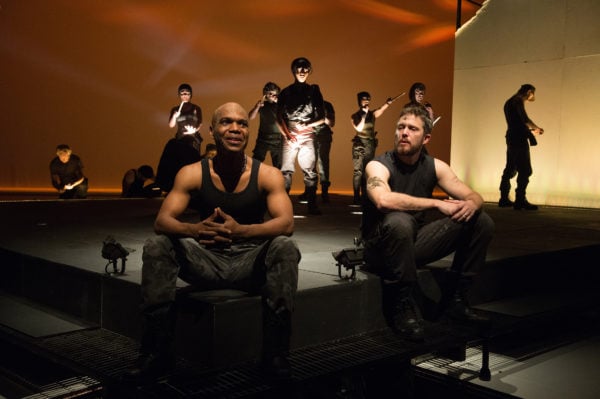
The portrayal of Antony was the most intriguing of all characters, especially with his famous “Friends, Romans, countrymen, lend me your ears” speech. Antony initially enters with the commoners, running around and yelling with the rest, but makes a dramatic impression as he weeps over Caesar’s body. Nevertheless, with the aforementioned monologue, Antony takes on a more devious persona, cutting in pertly with Caesar’s will and eventually tearing it up, as if he fabricated it for the sake of continuing his speech brimming with pathos. By the end, it’s impossible to tell whether Antony is driven more by a love for Rome like Brutus is, a love for Caesar or simply a love for his station as a former surrogate son of Caesar. Such an unknown plagues many public figures in society today, making him all the more fascinating.
The Oregon Shakespeare Festival’s productions of “Henry IV, Part 1” and “Julius Caesar” also both have thematic similarities, but are depicted in drastically different manners. The ending battles — one more realistic, the other symbolic — and couple relationship dynamics — one more flexible and contemporary, the other a more traditional male-female struggle — stood out as markers of Shakespearean theatrical literature. Each uniquely performed and produced, both plays are stunning works not to be missed.
“Henry IV, Part 1” will be performed at the Thomas Theatre until October 28 and “Julius Caesar” will be performed at the Angus Bowmer Theatre until October 29 at the Oregon Shakespeare Festival in Ashland, Oregon.
Contact Olivia Popp at opopp ‘at’ stanford.edu.
